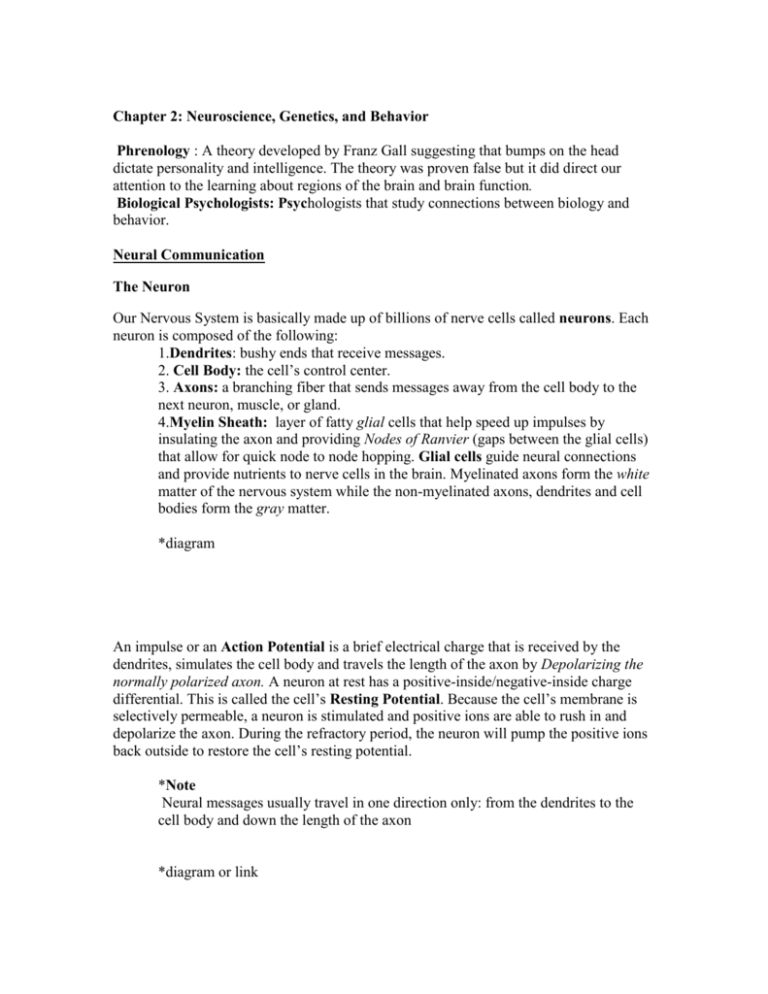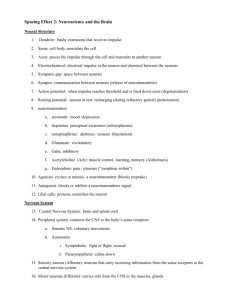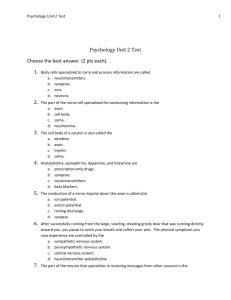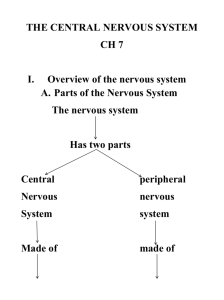Chapter 2: Neuroscience, Genetics, and Behaviors
advertisement

Chapter 2: Neuroscience, Genetics, and Behavior Phrenology : A theory developed by Franz Gall suggesting that bumps on the head dictate personality and intelligence. The theory was proven false but it did direct our attention to the learning about regions of the brain and brain function. Biological Psychologists: Psychologists that study connections between biology and behavior. Neural Communication The Neuron Our Nervous System is basically made up of billions of nerve cells called neurons. Each neuron is composed of the following: 1.Dendrites: bushy ends that receive messages. 2. Cell Body: the cell’s control center. 3. Axons: a branching fiber that sends messages away from the cell body to the next neuron, muscle, or gland. 4.Myelin Sheath: layer of fatty glial cells that help speed up impulses by insulating the axon and providing Nodes of Ranvier (gaps between the glial cells) that allow for quick node to node hopping. Glial cells guide neural connections and provide nutrients to nerve cells in the brain. Myelinated axons form the white matter of the nervous system while the non-myelinated axons, dendrites and cell bodies form the gray matter. *diagram An impulse or an Action Potential is a brief electrical charge that is received by the dendrites, simulates the cell body and travels the length of the axon by Depolarizing the normally polarized axon. A neuron at rest has a positive-inside/negative-inside charge differential. This is called the cell’s Resting Potential. Because the cell’s membrane is selectively permeable, a neuron is stimulated and positive ions are able to rush in and depolarize the axon. During the refractory period, the neuron will pump the positive ions back outside to restore the cell’s resting potential. *Note Neural messages usually travel in one direction only: from the dendrites to the cell body and down the length of the axon *diagram or link The intensity of a stimulus is called the Threshold. A stimulus must exceed the threshold in order for a transmission to occur. Much like a gun, the neuron either fires or it doesn’t, there are no half-fires. This is called the all-or-none-response. To differentiate between a really strong stimulus and a weak one, only the number of neurons firing will increase and not their speed. How Neurons Communicate The axon terminal of the sending neuron is separated from the receiving neuron by a tiny gap called the Synapse (or Synaptic Cleft). Once the action potential reaches the synapse, neurotransmitters, or chemical messengers, are released into the gap where they will bind onto specific receptor sites on the receiving neuron. These chemicals can either induce or inhibit neural firing. Scientists have isolated more than sixty neurotransmitters and a few of the more wellknown will be described throughout this course (Acetylcholine, Norepinephrine, Serotonin, Dopamine, Endorphins). Note: You will need to know their function and to with which disorders their under-abundance or over-abundance has been associated. For example: Acetylcholine (ACh): This is the most well know neurotransmitter and causes muscles to contract in movement. Endorphins: a neurotransmitter similar to morphine and is a natural opiate that are released in response to pain and heavy exercise and induce pleasure (explaining runner’s high, etc.). The following types of drugs can alter neurotransmission: 1. Agonists: molecules that mimic the shape of natural neurotransmitters and thereby mimic its effects. An example would be morphine binding to the same receptor sites to which endorphins bind. 2. Antagonists: molecules that block neurotransmitters from binding to receptor sites. It mimics a natural neurotransmitter but is not similar enough to stimulate the receptor and mimic the effect. An example would be curare, a poison used by South American hunters, mimic and block Ach sites thereby paralyzing prey. 3. Others: There are a variety of drugs that inhibit the natural breakdown or reabsorption of the neurotransmitter. An example would be Prozac, an anti-depressant drug that prevents the re-absorption of serotonin from the synapse allowing it to linger longer in the synapse thereby enhancing serotonin’s mood-lifting effect. The brain has a Blood-brain barrier that filters out unwanted chemicals in blood stream. This has its down side as well- When trying to treat chemical disorders of the brain researchers must develop a drug that must pass through the blood-brain barrier. For example, Parkinson’s patients show reduced levels of dopamine due to death of the neurons that produce it. Dopamine as a drug cannot pass through the barrier but given as L-dopa it can sneak through and be converted to dopamine in the brain. Neural and Hormonal Systems The Nervous System is composed two main systems: 1. Central Nervous System (CNS) – the brain and spinal cord. 2. Peripheral Nervous System (PNS) – This system connects the CNS to body’s muscles and glands by means of nerves which are bundles of sensory and Motor Neurons (they carry incoming and outgoing information respectively) via Interneurons which enable internal communication. It ‘s two main divisions are: a. The skeletal (somatic) system: This system controls voluntary movement of our skeletal muscles. b. The autonomic nervous system (ANS): This system controls the muscles of our internal organs and our glands. It is further subdivided into the Sympathetic Nervous System (arouses the body for defense (increase heartbeat, dilating pupils, inhibit digestion etc.) and the Parasympathetic Nervous System (calms the body after stress). *diagram A simple Reflex is coordinated by the nervous system and is an automatic response to stimuli (like knee-jerk) involving messages from Sensory to Interneuron (Spinal Cord) to Motor Neuron. *diagram or link The Endocrine System: It is the comparatively slow response system and it communicates by releasing Hormones (chemical messengers) into the bloodstream. In times of stress the autonomic nervous system will signal the Adrenal Glands (found above kidney) to release epinephrine and norepinephrine hormones (also called adrenaline and noradrenaline) which cause blood to be diverted to the body’s skeletal system to prepare for fight or flight. The Pituitary gland is the most powerful endocrine gland, and under the influence of hypothalamus in brain, pituitary releases hormones that regulate glands and growth. It also stimulates the adrenal gland to release the stress hormone cortisol. This stress response system is a good example of the interdependence between the nervous system and the endocrine system. The Brain The following is a list of the tools and techniques used to help gather information on the brain: 1. Lesions – The surgical destruction or removal of brain tissue. 2. Electroencephalogram (EEG) – A machine that measures brain electric activity. 3. Computed Tomograph (CT or CAT Scan) – This apparatus takes x-ray photographs of brain and can reveal brain damage. 4. Positron emission tomograph (PET Scan) – It detects radioactive glucose consumption in brain. Allows us to see active metabolic areas. 5. Magnetic Resonance imaging (MRI) – It generates detailed pictures of the brain’s soft tissues by making use of magnetic activity. Makes use of magnetic fields which appear to be less harmful than x-rays. Brain Structure The Brainstem– the oldest portion (the central core) in brain is made up of three main structures: 1. The Medulla Oblongata – regulates involuntary processes like heartbeat and breathing. 2. The Pons (“bridge”)- connects the two halves of the cerebellum lying above it and a portion of the reticular formation. It relays information about body movements that it receives from both higher brain centers and the spinal cord. It also appears to be involved in circuits that control sleep. 3. The Reticular formation- (looks like a finger-shaped net) controls arousal, when you wake or sleep. Damage to this area may cause a person to lapse into a coma. The Cerebellum (“little brain”)- found to the rear of the pons, looks like a miniature version of the forebrain with its two hemispheres. One area is involved in maintaining a sense of balance, another is involved in coordinating muscular movements while another part is involved in learning simple motor tasks. The Thalamus lies above brainstem and is shaped like two eggs. Its function is to act as a sensory switchboard (visual and auditory information as well as information about touch pressure temperature and pain). relaying incoming signals to appropriate brain regions. It does not relay sensory signals dealing with smell. The brain has two Cerebral Hemispheres, one on the right side and one on the left side. These two large structures that sit above the central core are the most recent development in the brain’s evolution. It consists of the limbic system and the cortex and is involved in the processes of learning, language, memory and reasoning. The right side of the brain is linked to sensations in the left side of the body while the left side of the brain is linked to sensations in the right side of the body. An exception to this would be visual sensations. Here, visual info from the left eye for example, does not solely go to the right hemisphere. In this case, the left half of your field of vision (in both eyes) goes to your right hemisphere while the right half of your field of vision (in both eyes) goes to your left hemisphere. The Corpus Callosum joins the two hemispheres and is separated to cure epileptic seizures. People with this separation are referred to as Spilt-brain patients. They are unable to say what they see in their left visual field because speech is in left hemisphere and the hemispheres regulate opposite sides of body. When split-brainers are asked to say what they saw, the left hemisphere will say what is seen in right visual field; when asked to point, get, or write what they saw, the right hemisphere will dictate what is seen in the left visual field. Sign language is nevertheless language and is control by left hemisphere, if deaf people get a stroke in left hemisphere, signing will be disrupted. Scientists have found hemispheric specialization. For example: 1. The left hemisphere appears to be more involved than the right in mathematics, language, logic, reasoning and the interpretation of events and behaviors. 2.The right hemisphere appears to be superior to the left at perceptual tasks such as copying drawings and information, face recognition, musical and artistic endeavors, and expressing emotion. * Read section on “Handedness” (right vs. left) in text. The Limbic System sits directly above the central core and forms the innermost border of the cerebral hemispheres. The limbic system includes the: 1. Amygdala – influences emotions (fear, anger). Stimulation of the area can cause an animal to flee. 2. Hippocampus – processes memory. Removal of amygdala results in emotionless organisms upon arousal. 3. Hypothalamus- maintains body homeostasis (temperature, hunger, growth) and governs the pituitary gland. For example stimulation of the lateral (side) hypothalamus will cause an animal to overeat while stimulation of the ventromedial (lower middle) hypothalamus will cause an animal to stop eating. The Cerebral Cortex, the outermost area of the cerebral hemispheres, is a thin layer of gray matter consisting of about 9 billion neurons covering the hemispheres. There are two deep fissures that subdivide each hemisphere into principle regions called lobes. The four main lobes are: 1. Frontal Lobe (behind forehead) – has the Motor Cortex located at the back of frontal lobe and controls voluntary movement. The case with Phineas Gage showed researchers that damages in the frontal lobe could result in personality alterations because their normal "restraints" or inhibitions are erased. This was due to a tamping rod that shot from his left cheek and out his head, separating his internal motives and external judgment. 2. Parietal Lobe (top to back of head) – has the Sensory Cortex located in the beginning of parietal lobe and receives information from the skin senses (touch, pressure, heat and pain) and for the sense of body position (vestibular sense). 3. Occipital Lobe (back of head) – very important in the analysis of visual information. 4.Temporal Lobe (above ears, below parietal lobes) – integrates sensory data with special attention to auditory data. *diagram or neuroscience for kids link 75% of the brain is not committed to motor or sensory functions. Theses brain regions are called Association Areas – areas that are involved in thinking, remembering, and speaking. With regards to evolution, the animal with the larger association area is the more intelligent the species with respect to anticipating future events. Language Language requires the coordination of many brain areas of the cortex. Damage to any one of these areas may result in aphasia (language impairment). Such damage has allowed researchers to piece together the stages in which language occurs: 1. Visual Cortex (occipital lobe) – allows us to see the visual stimulation (words). 2. Angular Gyrus (mid-side of parietal lobe) – converts words into auditory code. 3. Wernicke’s Area (left temporal lobe) – enables us to derive meaning from auditory code. 4. Broca’s Area (left frontal lobe) – controls motor cortex that in turn activates speech muscles to pronounce words. If there is damage to #1- one cannot see, #2- one cannot read, #3- one cannot understand, and #4- one cannot physically speak. . A Quick Review of Genetics and Behavior There are 23 chromosomes in human egg and sperm; they are combined (fertilized) to make a total of 46 chromosomes in housing the master plan for the organism. Chromosomes are composed of coils of DNA which in turn contain thousands of genes. It is these genes (protein recipes) that make each one of us the individuals that we are. Evolutionary Psychologists study the effects of evolution of and the behavior of organisms. Behavior Geneticists explore the ways that we differ from one another. They focus on how genetics and environment (upbringing) affect behavior. Molecular Geneticists use Linkage Analysis whereby they identify genes that are responsible for certain behaviors, disorders and diseases. Some of the most important information regarding genetic influences is found in studies using Identical Twins (two babies within one egg) and Fraternal Twins (two babies in 2 separate eggs) and often to contrast adoption studies. Identical twins have the same genes while fraternal twins do not. If for example it can be shown that there is a statistically significant larger number of identical twins (versus the fraternal twins) each having the same particular disorder, researchers can assume that there is a specific gene responsible for the disorder. Hertitability tells us what proportion of trait “variation” among people can be attributed to their genetic make-up (versus environmental factors such as upbringing , culture, etc.). If heritability of intelligence is 70%, it means that one can attribute 70% of the differences in intelligence among people to genetic influence. It is referring to the extent to which variation among individuals is due to each of them having different genes.









